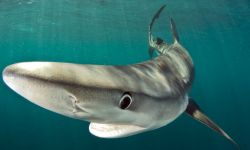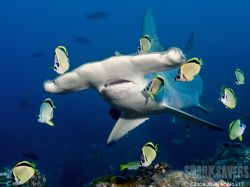By Tanya Brunner, MS
Sharks and rays share our senses – those of smell, taste, hearing, touch, and sight – but inhabit a world very different from ours: in the ocean, light and sound move at very different angles and speeds than in air. To travel the globe, locate other fish, and hunt prey in an aquatic medium, both sharks and rays have evolved two additional ways of perceiving their environment: they can sense electrical pulses and perceive both vibrations and pressure changes.

Sharks have a solid reputation for locating prey by smell, especially over long distances. However, they can also pick up on the small electrical fields generated by other animals (Campagno et al. 2005). Near the nostrils, around the head and on the underside of the snout, or rostrum, are small pores called ampullae of Lorenzini. Connected to the pores are long, jelly-filled bulbs that lead to nerves below the skin (Sharks: Silent hunters of the deep).
Sharks typically have several thousand ampullar pores; the scalloped hammerhead shark, for example, has over 3,000, and the number remains the same during the shark’s life (Kajiura 2001). In many elasmobranch species, the pores are most dense near the mouth, where prey movements are last sensed before being captured.
When light is scarce in murky water or at depths, and vision is impaired, this electromagnetic sense is especially useful for locating prey. Among skates, close relatives of rays, those that inhabit deeper habitats have larger ampullae than shallow-water skates (Raschi 1986). This difference in ampulla size is probably compensation by deep-water skates for their reduced ability to depend on vision for hunting.
Not only is electroreception used to locate other sharks or prey, but it is also employed as a compass during migration.
Hammerhead sharks are particularly skilled in this behavior: their broad head, called cephalofoil form, is thought to be an evolutionary result of placing importance, or more dependence, on this sixth sense while hunting and migrating. Having a head with large surface area allows hammerhead sharks to host a greater number of ampullae and higher pore density on the ventral, or bottom, surface of the head compared to other shark species (Kajiura 2001). Consequently, they can cover more ground in their search for food (Kajiura and Holland 2002).
Near the ampullae on the head of sharks, a seventh sense system is found. The lateral line shares structural similarities with the ampullae, and it is used to detect vibrations and changes in pressure caused by currents or other animals (Maruska 2001). The system is made up of canals that are sub-dermal, or below the skin, with tubes that lead to pores at the skin’s surface. The canals begin at the head of the fish and continue horizontally along each side of the body. Within the canals are neuromasts, clusters of sensory hair cells.
For example, as water flows past a rocky outcropping, its movement might change. If a shark approaches the structure and encounters the changing water movement, the shark’s neuromasts are pushed and pulled. This sudden interruption or change in direction of the hair cells’ normal movements indicates to the shark that something large is near. By registering neuromast shifts, sharks are constantly updated with information on their surroundings.
Campagno, L., M. Dando, and S. Fowler. 2005. Princeton Filed Guides: Sharks of the World. Princeton University Press: Princeton, New Jersey. Pg. 33.
Maruska, K.P. 2001. Morphology of the Mechanosensory Lateral Line System in Elasmobranch Fishes: Ecological and Behavioral Considerations. Environmental Biology of Fishes. 60(1):47-75.
Kalmijn, A. J. 1971. The Electrical Sense of Sharks and Rays. Journal of Experimental Biology. 55:371-383.
Kajiura, S. M. 2001. Head morphology and electrosensory pore distribution of Carcharhinid and Sphyrnid sharks. Environmental Biology of Fishes. 61(2):125-133.
Kajiura, S. M. and K. N. Holland. 2002. Electroreception in juvenile scalloped hammerhead and sandbar sharks. Journal of Experimental Biology 205:3609-3621.
Parker, S. and J. Parker. The Encyclopedia of Sharks. 1999. Firefly Books Ltd.: Buffalo, New York. Pg. 100-103.
Raschi, W. 1986. A morphological analysis of the ampullae of Lorenzini in selected skates (Pisces, Rajoidei). Journal of Morphology. 189(3):225-247.
Sharks: Silent hunters of the deep. 1993. Reader’s Digest: New South Whales, Australia. Pg. 34-37.